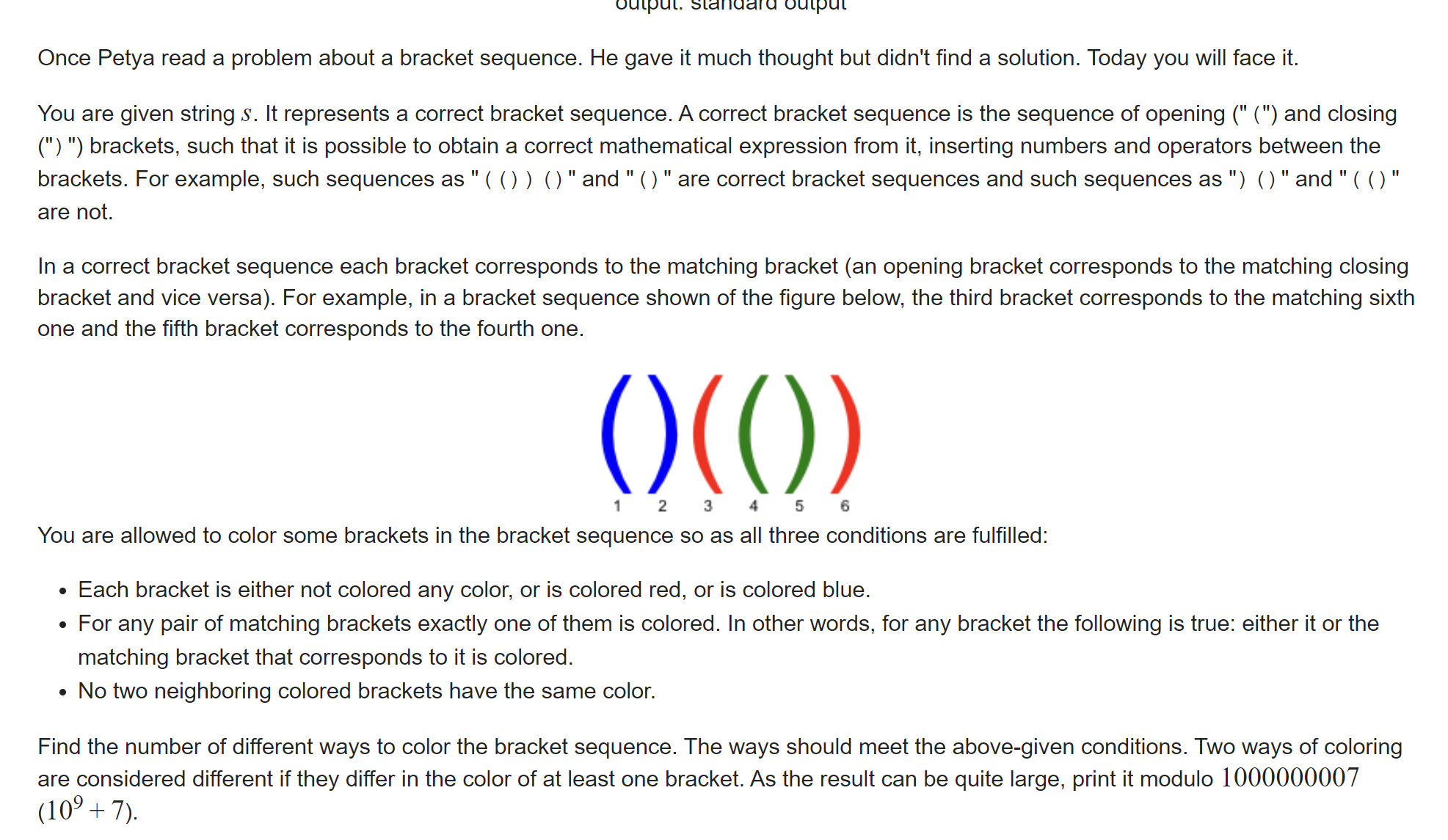D. Coloring Brackets

约定 ∣ S ∣ ≤ 700 |S| \leq 700 ∣S∣≤700
题意
给定一个正则括号序列 s s s,我们需要求出合法的染色方案数。合法的条件为:
- 每个符号要么不染色,要么染红色,要么染蓝色
- 对于每对配对的括号,它们中恰好有一个染色了,另外一个每染色
- 相邻的染色的字符颜色不能相同(没有染色允许相邻)
思路
可以发现每个左括号配对的右括号都是唯一的,我们可以使用栈来预处理出来,那么原本的 s s s 就被分成了若干个首尾配对的连续正则序列,例如 s = ( ( ( ) ) ( ) ) ( ) s = ( (())())() s=((())())() 可以分成: ( ( ( ) ) ( ) ) ((())()) ((())()) 和 ( ) () () 两个连续正则序列
这里是一个子状态,我们可以使用区间 D P DP DP 来计算。假设 d p [ l ] [ r ] [ c 1 ] [ c 2 ] dp[l][r][c1][c2] dp[l][r][c1][c2] 表示 l l l 的颜色为 c 1 c1 c1, r r r 的颜色为 c 2 c2 c2 时,区间 [ l , r ] [l,r] [l,r] 合法的方案数。
由于 s s s 本身是一个合法正则序列,我们先在外面枚举 c 1 c1 c1 和 c 2 c2 c2,进入 d f s dfs dfs 后,再根据它首尾是否配对,来分情况从不同的子状态转移过来。
- 如果 l 、 r l、r l、r 配对,也就是 l l l 位置的左括号和 r r r 位置的右括号配对,那么可以直接从子状态 d p [ l + 1 ] [ r − 1 ] dp[l + 1][r - 1] dp[l+1][r−1] 转移,注意要枚举子状态两端的颜色,并判断相邻颜色是否合法
- 如果 l 、 r l、r l、r 不配对,我们就要将区间 [ l , r ] [l,r] [l,r] 分裂成两个子区间 [ l , n x t [ l ] ] [l, nxt[l]] [l,nxt[l]] 和 [ n x t [ l ] + 1 , r ] [nxt[l] + 1, r] [nxt[l]+1,r],枚举 n x t [ l ] nxt[l] nxt[l] 和 n x t [ l ] + 1 nxt[l] + 1 nxt[l]+1 位置的颜色,判断是否合法再转移
由于这道题每个 l l l 都有唯一的一个配对位置 n x t [ l ] nxt[l] nxt[l],所以我们在做区间 D P DP DP 时就省去了枚举区间分裂点这一层操作,加上外层的 c 1 、 c 2 c1、c2 c1、c2 颜色枚举,复杂度大约为 O ( 9 ⋅ n 2 ) O(9 \cdot n ^ 2) O(9⋅n2)
#include<bits/stdc++.h>
#define fore(i,l,r) for(int i=(int)(l);i<(int)(r);++i)
#define fi first
#define se second
#define endl '\n'
#define ull unsigned long long
#define ALL(v) v.begin(), v.end()
#define Debug(x, ed) std::cerr << #x << " = " << x << ed;const int INF=0x3f3f3f3f;
const long long INFLL=1e18;typedef long long ll;template<class T>
constexpr T power(T a, ll b){T res = 1;while(b){if(b&1) res = res * a;a = a * a;b >>= 1;}return res;
}constexpr ll mul(ll a,ll b,ll mod){ //快速乘,避免两个long long相乘取模溢出ll res = a * b - ll(1.L * a * b / mod) * mod;res %= mod;if(res < 0) res += mod; //误差return res;
}template<ll P>
struct MLL{ll x;constexpr MLL() = default;constexpr MLL(ll x) : x(norm(x % getMod())) {}static ll Mod;constexpr static ll getMod(){if(P > 0) return P;return Mod;}constexpr static void setMod(int _Mod){Mod = _Mod;}constexpr ll norm(ll x) const{if(x < 0){x += getMod();}if(x >= getMod()){x -= getMod();}return x;}constexpr ll val() const{return x;}explicit constexpr operator ll() const{ return x; //将结构体显示转换为ll类型: ll res = static_cast<ll>(OBJ)}constexpr MLL operator -() const{ //负号,等价于加上ModMLL res;res.x = norm(getMod() - x);return res;}constexpr MLL inv() const{assert(x != 0);return power(*this, getMod() - 2); //用费马小定理求逆}constexpr MLL& operator *= (MLL rhs) & { //& 表示“this”指针不能指向一个临时对象或const对象x = mul(x, rhs.x, getMod()); //该函数只能被一个左值调用return *this;}constexpr MLL& operator += (MLL rhs) & {x = norm(x + rhs.x);return *this;}constexpr MLL& operator -= (MLL rhs) & {x = norm(x - rhs.x);return *this;}constexpr MLL& operator /= (MLL rhs) & {return *this *= rhs.inv();}friend constexpr MLL operator * (MLL lhs, MLL rhs){MLL res = lhs;res *= rhs;return res;}friend constexpr MLL operator + (MLL lhs, MLL rhs){MLL res = lhs;res += rhs;return res;}friend constexpr MLL operator - (MLL lhs, MLL rhs){MLL res = lhs;res -= rhs;return res;}friend constexpr MLL operator / (MLL lhs, MLL rhs){MLL res = lhs;res /= rhs;return res;}friend constexpr std::istream& operator >> (std::istream& is, MLL& a){ll v;is >> v;a = MLL(v);return is;}friend constexpr std::ostream& operator << (std::ostream& os, MLL& a){return os << a.val();}friend constexpr bool operator == (MLL lhs, MLL rhs){return lhs.val() == rhs.val();}friend constexpr bool operator != (MLL lhs, MLL rhs){return lhs.val() != rhs.val();}
};const ll mod = 1e9 + 7;
using Z = MLL<mod>;const int N = 750;Z dp[N][N][4][4];int main(){std::ios::sync_with_stdio(false);std::cin.tie(nullptr);std::cout.tie(nullptr);std::string s;std::cin >> s;int n = s.size();s = '0' + s;std::vector<int> nxt(n + 5, 0);std::stack<int> st;fore(i, 1, n + 1)if(s[i] == '(') st.push(i);else{nxt[st.top()] = i;st.pop();}auto check1 = [](int c1, int c2) -> bool { //检查相邻染色是否合法return !c1 || !c2 || c1 != c2;};auto check2 = [](int c1, int c2) -> bool { //检查首尾括号配对染色是否合法return (!c1 || !c2) && c1 ^ c2;};auto dfs = [&](auto self, int l, int r, int c1, int c2) -> Z {if(l > r) return 0;if(dp[l][r][c1][c2].x) return dp[l][r][c1][c2];if(l + 1 == r) return dp[l][r][c1][c2] = check2(c1, c2);Z ans = 0;if(nxt[l] == r){ //l r 配对,直接转移if(!check2(c1, c2)) return 0;fore(i, 0, 3)fore(j, 0, 3){if(!check1(c1, i) || !check1(j, c2)) continue;ans += self(self, l + 1, r - 1, i, j);}}else{ //l r 不配对,继续划分字串fore(i, 0, 3)fore(j, 0, 3){if(!check1(i, j)) continue;ans += self(self, l, nxt[l], c1, i) * self(self, nxt[l] + 1, r, j, c2);}}return dp[l][r][c1][c2] = ans;};Z ans = 0;fore(i, 0, 3)fore(j, 0, 3)ans += dfs(dfs, 1, n, i, j);std::cout << ans;return 0;
}
springboot实战——spring securtity注解方式的授权流程源码解析)
漏洞)

)
API的封装与调用)
)


)

)

![[word] word中怎么插入另外一个word文档 #媒体#职场发展](http://pic.xiahunao.cn/[word] word中怎么插入另外一个word文档 #媒体#职场发展)

、File类、递归 --黑马笔记)




